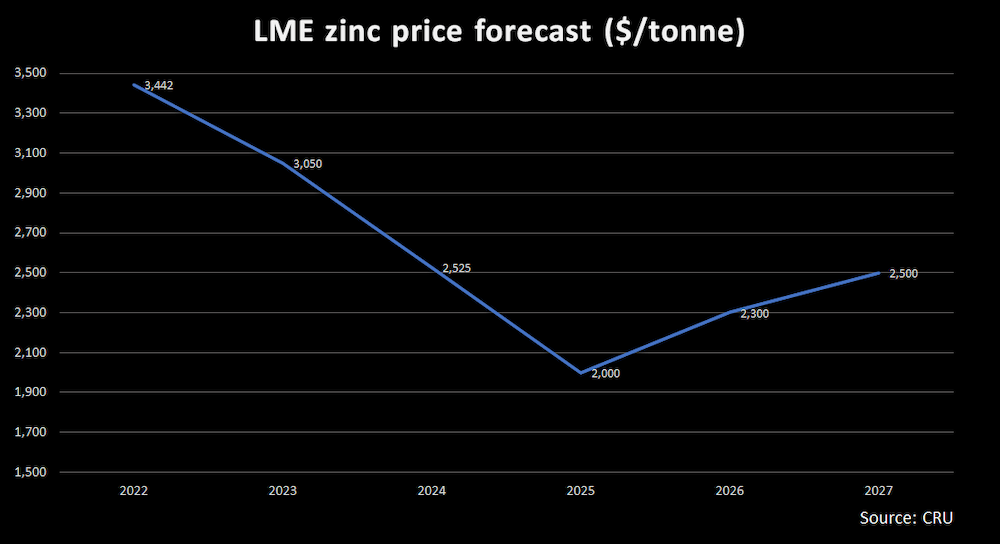The West is gagging for ex-China germanium supply and these ASX juniors are looking to ride that wave
Mining
Mining
Often found as a by-product in zinc deposits and a key component in infrared, fibre optics and high-end semiconductors, germanium is becoming a hot topic in the West as demand for the commodity heats up due to Chinese export restrictions that came into effect in August last year.
In 2022, China accounted for roughly 60% of global supply and as that starts to dwindle, production outside the Middle Kingdom is required to fill the gap for supply chains across the world.
And with zinc prices ready to bounce back by the time new projects get into production, germanium (Ge) as an extra source of income for miners makes up-and-coming projects more economically attractive.
Demand is forecast to rise again from next year and its price per tonne will follow suit too, according to the London Metals Exchange.

So who’s out there to fill the gap you ask? Good question. Let’s find out. But first…
Some say it was 1886 when the first blood was spilt between Russia and Germany when Clemens Alexander Winkler named germanium for the Fatherland after first being discovered by Russian chemist and teacher Dmitri Mendeleev.
Mendeleev put together what we all reference in schools, the periodic table, and subsequently what is now known as the periodic law – chemical elements arranged by atomic weight.
“I saw in a dream a table where all elements fell into place as required. Awakening, I immediately wrote it down on a piece of paper, only in one place did a correction later seem necessary.”
That correction included what Mendeleev correctly predicted as an element between silicon and tin, which he coined ekasilicon.
It had yet to be proved, and that’s where Winkler comes in and steals the show, becoming the first person to isolate the element, and whether narcissistically or not, named it germanium instead.
Little-known germanium is not so little known anymore, as the market has awoken to high demand for the element when China last year moved to restrict exports of the critical mineral, together with gallium and graphite.
We’re already seeing the effects, as according to China’s General Administration of Customs, sales of germanium were down 8% last year and are set to fall further, and while sales to Russia have increased, those to Japan and the US have started to dry up.
Speaking to Stockhead, Battery Age Minerals (ASX:BM8) CEO Nigel Broomham says the vacuum left by China and the ever-rising usage of germanium in advancing technology will make mining and processing the by-product increasingly valuable.
His company aims to reboot the Bleiberg base metal project which, up until 1993, was the world’s sixth largest producer of germanium.
“We think it’s incredibly important to have a high-grade germanium asset outside China-controlled areas,” Broomham says.
“With zinc prices comparatively about 3-5 times higher than when the mine was shut and a price rebound on its way in line with our development plans, we think Bleiberg is well-positioned to feed straight into the European market.”
BM8 stumbled upon tonnes of historical data from the old Bleiberg mine – a couple of centuries worth in fact – and is now in the process of sifting through it all to refine exploration targets and extend the resource.
Super high-grade germanium hits of >1,500ppm Ge were noted in those datasets.
“The dataset looks promising and will enable us to pull together a targeted and efficient exploration plan to prove the potential of the resource,” Broomham says.
Up in the Emerald Isle, Zinc of Ireland (ASX:ZMI) has its eyes on its own germanium-laden 11Mt Kildare zinc project, where a recent ‘Critical Element Study’ showed the potential for significant concentrations of germanium from all four key mineralised zones at Kildare.
Strategically located on the doorstep of mainland Europe, results obtained from pXRF analyses on 906 samples within areas of previously identified zinc-lead mineralisation at Kildare revealed the potential of significant concentrations of germanium from all four key target zones, with samples showing up to 433g/t Ge.
ZMI is now running a fine-toothed comb over 50km worth of historic drill cores that were never assayed for germanium.
“We are excited to use our existing data and drill core to expedite quantifying the germanium extent at potentially one of Europe’s largest undeveloped deposits,” ZMI MD Thomas Corr told Stockhead earlier this month.
Down to Africa, Mount Burgess Mining (ASX:MTB) is proving up its Kihabe-Nxuu polymetallic project in Botswana where it’s found evidence of strong germanium and gallium grades.
Samples have been submitted to laboratories for metallurgical test work to confirm to what extent the two critical minerals can be recovered from the project.
At Stockhead we tell it like it is. While Battery Age Minerals and Zinc of Ireland are Stockhead advertisers, they did not sponsor this article.